Abstract
The purpose of this study consists in determining the contribution of every specific function concerning the cultural activities of Mountain Sports Activities: social function (social adjustment and accommodation), recreational function (entertainment, spending and organizing of free time), educational function, correctional function (prevention of conflicts, limitation of the social-cultural deviation), and critical function (searching and creating new reports between the individual and the group), all this having as perspective the widening of the consciousness of the University of Bucharest’s students. The method of questionnaire, the mathematical-statistical method and the graphical method were applied. 121 subjects participated, 64 girls (52, 90%) and 57 boys (47, 10%), first and second year students at the 18 faculties of the University of Bucharest, enrolled on the courses of sport and physical education. At the beginning of the school year, these students opted for the
Keywords: Cultural activitiesaccommodationparticipateself -knowingcreativity
Introduction
The conducted analysis provides a statistical argumentation regarding the influence of cultural activities on students and the impact which this subject matter had over the years. We aimed to complete the curriculum of ”Mountain Sport Activities” subject matter for the students in the first and second academic years, at the University of Bucharest, and therefore contribute not only to building a minimal set of practical and methodical knowledge, but also to develop social communication and increase human awareness meant to relieve everyday stress.
According to the Educational Plan, two or three mountain applications are scheduled each semester of the academic year. Each stage runs for three days and usually takes place over the weekend.
This schedule generates an advantage for students who do not have to miss classes, since physical education is mostly optional.
The mountain routes nearby are part of the Bucegi Mountains circuit, the zonal mountain variants that allow groups to return every day, in due time, to the premises of the facility where they are accommodated and also complete the other scheduled steps –courses, non-formal recreational activities.
”Thus, the World Tourism Organization recommended to countries, as early as 1975, to include tourism and travels in the curriculum of schools and universities, due to their educational role. At this level, it is an acknowledged fact that tourism plays a role both in terms of the aspirations of knowing and understanding your own age, and in terms of a feeling of detachment from the family protection. Therefore, tourism should be seen as a young people’s right and a serve of an important social interest. On the social side, the training-educational function of tourism requires knowledge of reality, creating emotions and therefore facilitative creative activities; for those who are socially awkward, tourism facilities a new socializing process, and for those with walking problems, revalidation is facilitated” (Pelin, Stroe, & Vasilescu, 2010, p.51).
“More than ever, tourists seem to be classified into two distinct categories: those looking for standardized tourist products and services, and those willing to have authentic experiences” (Păduraru, Ungureanu, & Tacu, 2015, p.2).
Just as with the definitions of cultural tourism, there is more than one typology being used. The five types are presented in Table no. 1.
"Mountain areas have always been an attraction, as they facilitate various sport activities which triggered the development of mountain resorts" (Pârvu & Fleşeriu, 2018, p.1).
The authors Marković & Petrović (2013, p.80) focus on the mountains as being places for travel, sports and tourist recreation, considered as the main touristic holiday activities.
One strategy for going beyond seasonality is to develop the resorts for the four seasons, so that sport and entertainment facilities are open throughout the whole year, not only in winter when the focus is on winter sports only“ (Monitoring Network in Tourism, 2018c).
"By organizing trips with students, we have the possibility to contribute to the development of their personality by capitalizing on their interests and skills. They learn to cherish the cultural, folk and historical values of our people and show interest in learning as much as they can in that respect. The trip strengthens not only the students’ body, but also their mind, by nourishing good personality traits” (Zlate, 2017, p.2).
According to Cârstea (2000, p.42), the socializing activity of tourist groups is about ”developing your responsibility in achieving certain tasks or objectives, building the respect for the colleagues’ efforts, the understanding of the need for a role hierarchy within the group, as well as developing organizational habits and skills, etc.”
According to authors Pelin, Stroe and Vasilescu (2010, p.52) “the facilitator has the following tasks:
carry out educational activities, as well as (physical and mental) relaxation activities;
carry out an activity meant to raise awareness on the tourist potential of the area;
organize ad-hoc contests or competitions, by developing a appropriate set of rules for that purpose;
support activities of an educational nature;
organize cultural evening events including age-specific games taking place inside the chalet, competitions such as ”who knows wins” or dance, poem reading and singing contests;
organize easy tourist orientation contests, near the camp;
have a package of movement (collective and individual) games, which he/she will organize in the open air, as well as inside, such as chalet games, as well as procuring the supplies for organizing the program specific to the ”camp fire”.
”Generally speaking, facilitation means any action carried out in or on a group, a community or an environment, meant to develop communication and ensure social life, by using entertaining or semi-entertaining methods” (Uscatu & Istrate, 1993, p.155).
”Starting from the variety of learning situation and the various degrees of intention specific to actions, education can be classified into three categories, based on its goals: formal, non-formal and informal” (Cucoş, 2006, p.47).
”Mountain hiking (in an organized way) is important for young people, since it helps them develop their personality. Climbing and descending from a mountain, that is walking on a inclined area, are exercises which can be done by anyone, provided that they are aware of their physical possibilities and choose an accessible trail as a result” (Dumitrescu, 2013, p.84).
Mountain tourism often combines the recreational and the sport aspects, and is therefore an instrument of physical education, as well as a training and educational objective.
Cultural tourism is “the movement of persons to cultural attractions away from their normal place of residence, with the intention to gather new information and experiences to satisfy their cultural needs” (Richards, 1996, p. 24).
”Social benefits achieved by tourism: better ability to socialize; build friendships; adapt to environmental conditions; become aware of social rules and values; accept personal mistakes, accept the mistakes made by colleagues or friends; express your personality” (Enoiu & Enoiu, 2008, p.87).
”This is the reason why I don’t see the perspective that supports the synergetic and dialectic relation between emotion and affection, that gives expressively cultural and civility qualities to human behaviour as an exaggeration”(Neacşu, 2010, p.161).
Problem Statement
The physical education methods create, by way of the teaching tourism, many opportunities for social and human relationships, helping others and developing the group spirit. These practical methods can also help in acquiring knowledge about bio-diversity and geo-diversity, the cultural and historical heritage. The topography, landforms and ecosystem of those places can be opportunities for connecting students from various specializations (science, humanities) to the reality of the region, by the harmless exploration of the sites.
In this context, the students that attend faculties other than sport and physical education are particularly entitled to have thorough knowledge about tourism, sport orientation and ecology, and about how can this be mixed with the other pedagogical, psychological, sociological, biological etc. notions acquired during faculty, which will result in there and the future generations’ education and development.
Research Questions
Cultural activities in the mountain environment can be a process of self-awareness, since it provides the conditions required that any individual discovers himself.
The interaction between individuals and groups and the environment, the expression of your own self, your own initiative and responsibility can generate a creativity process with multiple educational possibilities for the entire life.
Purpose of the Study
Checking how valid the influence of the cultural activities’ functions is on young students, in terms of communication development and social life, by using entertaining methods and means.
Research Methods
Research methods included study of reference works, the Market Research questionnaire method, the statistical methods and the graphical method by using the Microsoft Office Excel 2007 software.
Time and place of the research
The study was conducted at the University of Bucharest between November 2017 and April 2018.
The subjects are students in the 1st and 2nd academic year attending one of the 18 faculties of the University of Bucharest, are aged between 19 and 30 years, and were involved in the Mountain Sport Activities classes
The questionnaire was filled out by 121 students, of which 64 were girls, accounting for 52,90% of respondents and 57 were boys, accounting for 47,10%, of respondents.
The data were collected based on a questionnaire that was sent online.
All subjects received written information about the purpose of the study and give their informed consent about the data use in accordance with the Declaration of Helsinki, the Amsterdam Protocol and Directive 86/609/EEC. The approval of the Ethics Committee of the University of Bucharest and the Physical Education and Sport Department was obtained.
Findings
The subjects’ to the questionnaire is set out based on the five key indicators.
Social function
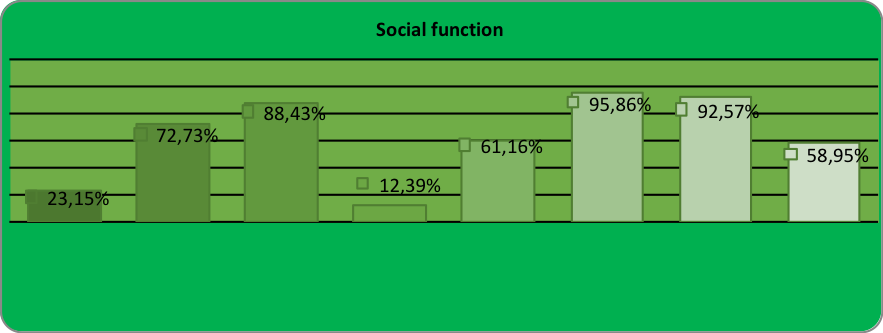
Figure no. 1, shows the percentage distribution of the eight indicators specific to the
- almost 2/3 (73,56%) of the students completing the questionnaire make friends easily and very easily 72,73% can rely on their friends’ support, and 88,43% are motivated and optimistic with regard to the achievement of the plans they set for themselves, both within a group and individually;
- 12,39% of subjects do volunteering work in the environment greening area 61,60% do other forms of social and humanitarian volunteering work 95,89% have a helping spirit, responding to their colleagues’ needs, while 92,57% were helped in certain circumstances;
- at the end of each day dedicated to classes and hands-on lessons mixed with cultural evenings 76,85% of subjects like to exchange impressions, and 65,29% like to draw conclusions about what happened.
Recreational function

Figure no. 2, shows the percentage distribution of the seven indicators specific to the
- 100% of the subjects say that they enjoy team activities;
- in the first three options regarding music genres, we have identified the
- they like to sing at the campfire 61,99%, in artistic nights 45,46% or karaoke 38,02%, and among the most loved camp games we identify playing cards 91,73% followed by rummy 72,73%, chess 42,15% and backgammon 38,02%.
Educational function
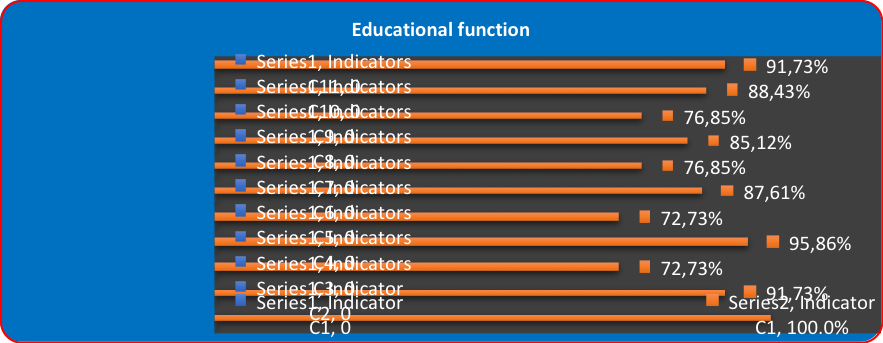
Figure no. 3, shows the percentage distribution of the eleven indicators specific to the
- subjects confirm the benefits of this type of education in proportion of 91,73% and have categorised the first three types: non-formal education 72,73%, followed by formal education 38,73% and informal education 34,71%;
- regarding the managerial roles of the coordinative teacher, the respondents have categorised the first three places: the
- the self esteem development is confirmed by respondents with the help of these activities by 72,73% and the reach of goals that have been set has brought a plus of trust encouraging them regarding initiatives, as well as improving the in the creativity chapter by the nature of unforeseen situations, and the adaptability of finding quick solutions regarding unusual situations 76,85%;
- organisation, self-organisation centred on formative initiatives, as well as, the improvement of general knowledge have won some ground in the habits of the questioned subjects 84,12% the positive attitudes have helped them to prove tolerance and humanitarianism, mutual support and a beginning of a healthy lifestyle.
Correction function
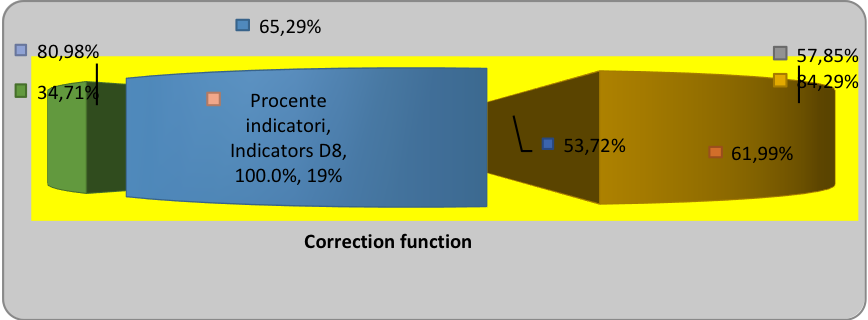
Figure no. 4, shows the percentage distribution of the four indicators specific to the
- the data obtained from a percentage of 53,72% of the respondents that have chosen the
- the efficiency of the drawn conclusions at the end of every activity day, is recognised by 84,29% of the respondents, and the achievement of proposed objectives have confirmed the benefits regarding the development of self image 100% of them have mentioned the
Critical function
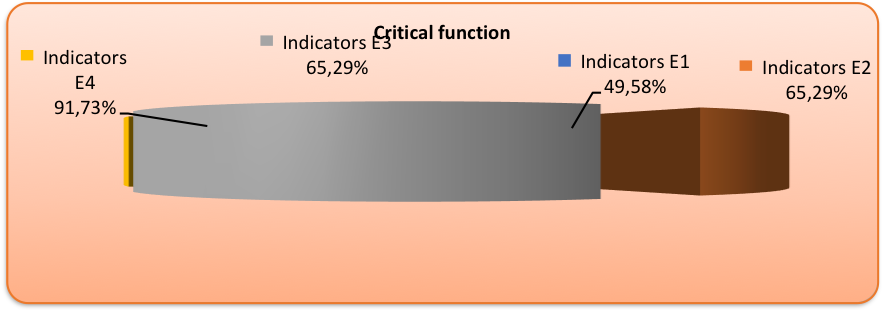
Figure no. 5, presents the percentage distribution of the four indicators specific to the
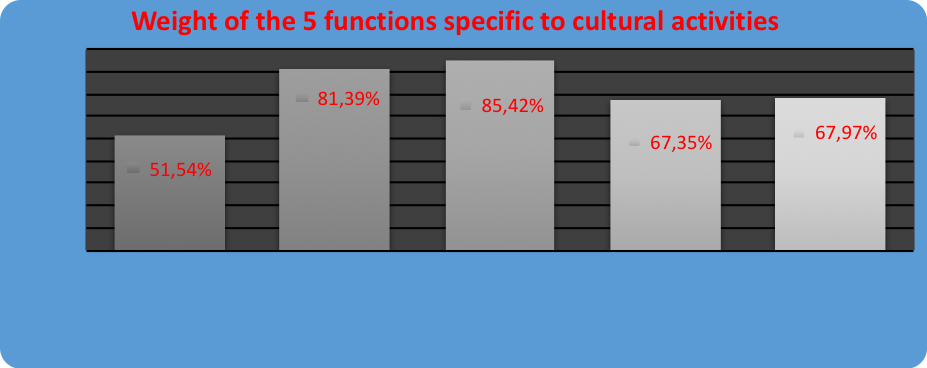
Figure no. 6, shows the percentage distribution of the five basic indicators and reveals that the most significant percentages were allocated to
Conclusion
The study confirms the working hypotheses, namely the influence of the cultural activities on the students who are enrolled in the
Acknowledgments
This study is important for the specialised professors of the University of Bucharest and not just them, but also the students we are working with, whom sent us a positive feedback, that revealed the major contribution of cultural activities, which undoubtedly became an important “niche” within mountain activities.
References
- Cârstea, Gh. (2000). Teoria şi metodica educaţiei fizice şi sportului. Pentru examene de definitivat şi gradul didactic II [Theory and methodology of physical education and sport. For final exams and teaching degree II], Bucharest: AN-DA Publishing House.
- City Tourism & Culture the European Experience A Report produced for the Research Group of the European Travel Commission (ETC) and for the World Tourism Organization (WTO) by LAgroup & Interarts, Brussels, February 2005 ETC Research Report N° 2005/1, City Tourism and Culture, Chapter 1, p.4, Retrieved from http://81.47.175.201/stodomingo/attachments/article/122/CityTourismCulture.pdf
- Cucoş, C. (2006) .Pedagogie, Ediţia a II-a, [Pedagogy II Edition], Bucharest: Polirom Publishing House.
- Dumitrescu, R. (2013). Activităţi sportive montane şi nautice [Mountain and Nautical Sports], Bucharest: University of Bucharest Publishing House.
- Enoiu, R. & Enoiu, R.S. (2008). Activităţile de educaţie fizică în Universitatea Transilvania [Physical education in Transylvania University], Braşov: University of Transilvania Publishing House.
- Marković, J.J. & Petrović, M.D. (2013). Sport and Recreation Influence upon Mountain Area and Sustainable Tourism Development, Journal of Environmental and Tourism Analyses, 1 (1), 80.
- Neacşu, I. (2010). Introducere în psihologia educaţiei şi a dezvoltării [Introduction to psychology of education and development], Bucharest: Polirom Publishing House.
- Păduraru, T., Ungureanu, D. & Tacu, G. (2015). Turismul rural românesc în contextul dezvoltării durabile. Actualitate şi perspective [Romanian rural tourism in the context of sustainable development. Actuality and perspectives News and views, XXXVI volume], Iaşi: PIM Publishing House.
- Pârvu, I.N. & Fleşeriu, C. (2018) .Bune practici turismul montan: referinţă la literatură [Good practices in mountain tourism: reference literature], Revista de turism, studii şi cercetări în turism [A Magazine of travel, studies and research in tourism].
- Pelin, P., Stroe, S. & Vasilescu, D. (2010). Excursii şi drumeţii [Trips and hiking], Bucharest: Discobolul Publishing House.
- Réseau de veille en tourisme, 2018c [Monitoring Network in Tourism, 2018c], Mountain destinations: Trends and best practices in tourism, Retrieved from http://www.tourismintelligence.ca/2011/11/15/mountain-destinations-trends-and-best-practices-in-tourism/, accessed 16.04.2018
- Richards, G. (1996, ed.). Cultural Tourism in Europe. CABI, Wallingford, re-issued in 2005 in electronic format by the Association for Tousism and Leisure Education (ATLAS), Retrieved from http://www.tram-research.com/cultural_tourism_in_europe.PDF
- Uscatu, T. & Istrate, I. (1993). Vacanţe şi turism [Holidays and Tourism], Bucharest: Doris Publishing House.
- Zlate, C. (2017). Contribuţia activitǎţilor extracurriculare la dezvoltarea personalitǎţii elevilor [Contribution of extracurricular activities to the development of students’ personality], Convorbiri didactice [Didactic conversations] Tulcea: Casa corpului didactic Publishing House, No. 14, January, p.2, Retrieved from https://ccdtulcea.ro/wp/wp-content/uploads/revista/14/28.Zlate-Cristina_Contribu%C8%9Bia-activit%C7%8E%C8%9Bilor-extracurriculare-la-dezvoltarea-personalit%C7%8E%C8%9Bii-elevilor.pdf
Copyright information

This work is licensed under a Creative Commons Attribution-NonCommercial-NoDerivatives 4.0 International License.
About this article
Publication Date
15 August 2019
Article Doi
eBook ISBN
978-1-80296-066-2
Publisher
Future Academy
Volume
67
Print ISBN (optional)
-
Edition Number
1st Edition
Pages
1-2235
Subjects
Educational strategies,teacher education, educational policy, organization of education, management of education, teacher training
Cite this article as:
Dumitrescu*, R., & Aducovschi, D. (2019). The Influence Of Cultural Activities On Students Engaged In Mountain Sports Activities. In E. Soare, & C. Langa (Eds.), Education Facing Contemporary World Issues, vol 67. European Proceedings of Social and Behavioural Sciences (pp. 1580-1588). Future Academy. https://doi.org/10.15405/epsbs.2019.08.03.193
